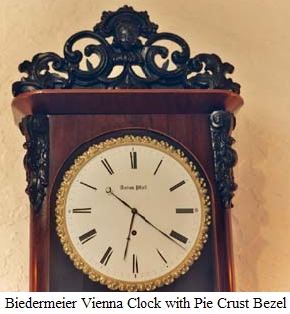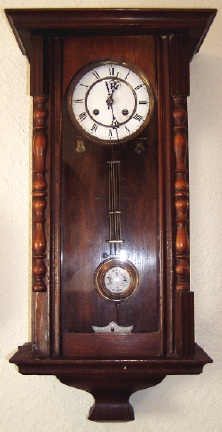|
The Vienna Regulator
The Vienna clock, or Vienna regulator as it is called, is an elegant antique wall clock made from fine woods and with a precise and complex mechanism made from around 1790 to 1910 in the region now occupied by Germany and Austria. Many fine examples of Vienna regulators exist in the United States and Vienna clocks that are in good condition continue to command a high price in the antique clock marketplace. In addition to the high quality clock works, the clock case of the Vienna clock is a piece of art in itself and makes a stylish addition to any home that is decorated in a classical style. Over the 120 year history that the Vienna clocks were popular in both Europe and the United States, the style of the clock case followed the trends in furniture styles. During the fifty years from 1790 to 1840, the Vienna clocks typically featured straight lines and flat surfaces reflecting the Empire style in furniture of this time period. The features of these Vienna clocks resemble a carriage lamp design of the period. The dials of a Vienna clock are typically fancier than the hand painted flat metal dials of American clocks of the same period. With the advanced
European
technology of manufacturing available to the makers, the clock face of a Vienna regulator is frequently made of a single piece of curved porcelain with a fine shine to the finish. These clock dials reflect the quality of German and Austrian porcelain available during the late 1700’s and early 1800’s.
The Biedermeier style of Vienna clock appeared around 1840 and was the predominant style until around 1870. These Vienna clocks were fancier than the previous Empire style and featured rounded corners and curved tops with crests. The dials shifted some in style as well, to what is called a pie crust bezel, as shown above. Later Vienna clocks are classified under the Altduetsch style. Vienna clocks with the Serpentine, Baroque and Art Deco styles were prevalent until Vienna clocks lost popularity around 1910. These later clocks featured graceful lines and most likely had a fancy case that included a carved crest, ornate columns, plus finials and possibly an embossed pendulum.
No matter what style period a Vienna regulator represents, it is a wonderful example of fine craftsmanship in both the clock works and the artistry of the clock case. Any of these clocks, European or American, make excellent additions to your home. Most of them have been ticking away for over a century, and will probably still be ticking a hundred years from now. Need more information?

|




